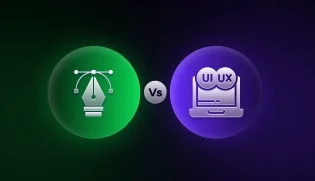
8 Excellent Product-based Companies for UI/UX Designing
Mar 04, 2025 5 Min Read 7328 Views
(Last Updated)
In today’s tech-driven world, the demand for exceptional user experiences has never been higher. From smartphones and websites to software applications and digital services, the role of UI/UX designers has become increasingly important. For Product-based companies that solely depend on their product, these user experiences are very important.
In this article, we’ll explore the product-based companies that prioritize the expertise of UI/UX designers. The companies listed in this section recognize the critical importance of user-centered design in creating products that not only meet user needs but also stand out in a competitive market.
Let us understand more about this in this article by first learning about the need for UI/UX designers in product-based companies and then you’ll learn about the companies that offer a prominent role for UI/UX designers.
Table of contents
- Need for UI/UX Designers in Product-based Companies
- Best Product-based Companies for UI/UX Designing
- Netflix
- Dropbox
- Meta
- Adobe
- Microsoft
- Zendesk
- Amazon
- Conclusion
- FAQ
- What is UI/UX designing in product-based companies?
- Why is UI/UX designing essential for product-based companies?
- What skills are essential for a UI/UX designer in a product-based company?
- How does UI/UX design affect a product's market competitiveness?
- How can a company measure the success of its UI/UX design efforts?
Need for UI/UX Designers in Product-based Companies

As the name suggests, product-based companies depend solely on their products, and selling them puts money in their pocket. In this digital age, to sell a product is to make it visually appealing and easily accessible. This can be done only by UI/UX designers.
The future and scope for UI/UX designing are very promising as these designers are essential in product-based companies because they make products more user-friendly and visually appealing. So, learning UI/UX is important now.
They play a crucial role in understanding user needs, simplifying complex interfaces, and ensuring that the product is enjoyable and easy to use.
This not only enhances user satisfaction but also increases the product’s competitiveness and market success, as a positive user experience is often a key factor in attracting and retaining customers.
As we move on to the next section, ensure you understand the fundamentals of UI/UX, including heuristic analysis, journey maps, testing, etc. If you want to explore more about it, join GUVI’s UI/UX Course with placement assistance. You’ll also learn about the tools used in UI/UX: AdobeXd, Illustrator, Photoshop, Figma, and many more. Build some fantastic real-time projects to get hands-on experience.
Also, if you want to explore Figma through a Self-paced course, try GUVI’s Figma certification course.
Best Product-based Companies for UI/UX Designing
The world is booming with product-based companies as the demand started increasing so is the supply. Almost every other product-based company is in need of a UI/UX designer and their roles and responsibilities keep on increasing.
There are several product-based companies that are known for their exclusive focus on UI/UX design that not only benefits the customers but also gives a chance for the designers to improve their personality and skill.
Here’s a list of some notable product-based companies that provide a suitable work environment for UI/UX designers:
1. Netflix

A UI/UX designer at Netflix plays an important role in shaping the way millions of viewers interact with the platform and enjoy their favorite content.
In this role, you’d be responsible for creating a visually appealing and user-friendly interface that guides users seamlessly through their streaming experience.
Your work involves a deep understanding of user behavior, preferences, and needs to design intuitive layouts, navigation menus, and interactive elements that enhance the overall user experience.
Your role would also involve conducting usability testing, analyzing user feedback, and continuously iterating on designs to ensure they align with Netflix’s commitment to delivering a top-tier streaming service.
Ultimately, as a UI/UX designer at Netflix, you’d have the opportunity to influence how people around the world engage with entertainment, making their streaming journeys as enjoyable and effortless as possible.
- Link to apply: Netflix
- Average Salary: 5 LPA
2. Dropbox

Dropbox is a cloud storage and file-sharing platform. As a UI/UX designer, your main responsibility is to ensure that the Dropbox application is not only visually appealing but also highly intuitive and user-friendly.
Your goal is to create a seamless and efficient workflow for users as they manage and share their files in the cloud. This may involve creating wireframes, prototypes, and high-fidelity mockups that guide the development process.
You would also focus on consistency in design across various platforms, ensuring that the Dropbox experience remains cohesive whether users access it on a desktop, mobile device, or web browser.
- Link to apply: Dropbox
- Average Salary: 4.5 LPA
3. Meta

As a UI/UX designer at Meta, you would have a fascinating and impactful role in shaping user experiences across a range of products and platforms, including Facebook, Instagram, WhatsApp, Oculus, and more.
Your primary focus would be on understanding the diverse needs and behaviors of users and using that knowledge to design interfaces that are not only visually appealing but also highly engaging and user-friendly.
Your responsibilities would include conducting user research to gain insights, creating wireframes and prototypes to visualize your design ideas, and collaborating closely with cross-functional teams of product managers, engineers, and researchers.
Whether you’re working on improving the way people connect with friends and family on Facebook, enhancing the visual storytelling capabilities on Instagram, or optimizing the immersive experiences on Oculus VR devices, your designs would play a critical role in creating a more connected and interactive digital world.
- Link to apply: Meta
- Average Salary: 6.0 – 9.4 LPA
4. Adobe

One of the important product-based companies for UI/UX designers is Adobe, and here, you would play an important role in shaping the user experience for some of the most popular and widely-used creative software applications in the world, including Photoshop, Illustrator, and Adobe XD.
Your journey would begin by diving deep into understanding the needs and workflows of Adobe’s diverse user base, which includes graphic designers, illustrators, photographers, and UX/UI designers.
Your work would extend to ensuring a consistent and cohesive user experience across Adobe’s suite of creative tools, regardless of whether users are on desktop or mobile platforms.
Your designs would have a profound impact on the way creative professionals bring their ideas to life, enabling them to work more efficiently, express their creativity, and produce stunning digital content.
- Link to apply: Adobe
- Average Salary: 4.5 LPA
5. Microsoft

As a UI/UX designer at Microsoft, your role revolves around creating user-friendly and visually appealing interfaces for a wide range of products, such as Windows, Office, and other software and services.
Your primary focus is on understanding the needs and behaviors of users to design interfaces that are intuitive and enhance their overall experience.
Your work also extends to ensuring consistency in design across various Microsoft products and platforms, making sure that users have a seamless experience whether they’re using a desktop application, a mobile app, or a web-based service.
Ultimately, your role as a UI/UX designer at Microsoft is to play a pivotal role in enhancing the usability and overall satisfaction of millions of users who rely on Microsoft products in their daily tasks and activities.
6. Zendesk

As a UI/UX designer at Zendesk, your role is all about improving the user experience within Zendesk’s customer service and engagement platforms.
Your main focus is to create interfaces that are not only aesthetically pleasing but also highly functional and user-friendly, making it easier for businesses and customer support teams to provide exceptional service.
Your responsibilities start with understanding the needs and pain points of both customers and support agents. You would conduct user research, gather feedback, and analyze user behavior to gain insights into how to enhance the software’s usability.
Ultimately, your role as a UI/UX designer at Zendesk is to contribute to the company’s mission of providing tools that help businesses build better customer relationships, streamlining their support processes and making customer interactions more efficient and enjoyable for all involved parties.
- Link to apply: Zendesk
- Average Salary: 5 – 7 LPA
7. Amazon

As a UI/UX designer at Amazon, your primary responsibility is to create user interfaces that enhance the shopping experience for Amazon customers.
Your role involves making sure that the Amazon website and mobile app are not only visually appealing but also easy to navigate and use.
Your day-to-day work begins with understanding the needs and behaviors of Amazon’s diverse customer base. This involves conducting research to gain insights into how people shop online, what challenges they face, and what they expect from an e-commerce platform.
Ultimately, as a UI/UX designer at Amazon, your goal is to contribute to Amazon’s mission of providing customers with a user-friendly and enjoyable shopping experience, making it easy for them to find, purchase, and enjoy a wide range of products from the Amazon marketplace
- Link to apply: Amazon
- Average Salary: 4 – 10 LPA
8. Google

Your role as a UI/UX designer at Google is important in crafting the user experiences of some of the world’s most widely used products and services, including Android, Google Search, Maps, and many more.
Your primary focus is to ensure that these digital platforms are not only visually appealing but also incredibly user-friendly, making it effortless for users to access information and interact with the services they rely on daily.
Your role extends to maintaining design consistency and coherence across various Google platforms and devices, ensuring a seamless and unified experience for users, whether they’re using a desktop computer, a smartphone, or other emerging technologies.
Ultimately, as a UI/UX designer at Google, you play a pivotal role in making information and technology accessible and user-friendly for billions of people worldwide, contributing to Google’s mission of organizing the world’s information and making it universally accessible and useful.
- Link to apply: Google
- Average Salary: 5.4 – 12 LPA
Kickstart your UI/UX journey by enrolling in GUVI’s UI/UX Course where you will master technologies like AdobeXd, Illustrator, and Figma, and build interesting real-life UI/UX projects.
Alternatively, if you would like to explore Figma through a Self-paced course, try GUVI’s Figma certification course.
Conclusion
In conclusion, the importance of UI/UX design in product-based companies is dynamic and ever-evolving. As we’ve explored the companies that prioritize user-centric design, it’s evident that they understand the profound impact of a well-crafted user experience.
From Apple’s sleek devices to Google’s intuitive software, and Amazon’s seamless shopping, these companies have demonstrated that exceptional design isn’t just a luxury—it’s a necessity in today’s digital world.
UI/UX designers play an important role in ensuring that technology enhances our lives, making it easier, more enjoyable, and accessible. As technology continues to advance, the partnership between innovative product companies and skilled UI/UX designers promises to bring us even more exciting and user-friendly experiences in the future.
FAQ
UI (User Interface) and UX (User Experience) designing in product-based companies involves creating visually appealing and user-friendly interfaces to enhance the overall user experience of their digital products.
UI/UX designing is crucial because it ensures that products are user-friendly, engaging, and meet customer needs, which directly impacts user satisfaction and product success.
Essential skills include user research, wireframing, prototyping, usability testing, and proficiency in design tools like Sketch, Figma, or Adobe XD.
UI/UX design can set a product apart from competitors by offering a superior and more enjoyable user experience, attracting and retaining customers.
Success can be measured through user satisfaction surveys, user retention rates, reduced customer support inquiries, and positive app store ratings and reviews.



















Did you enjoy this article?